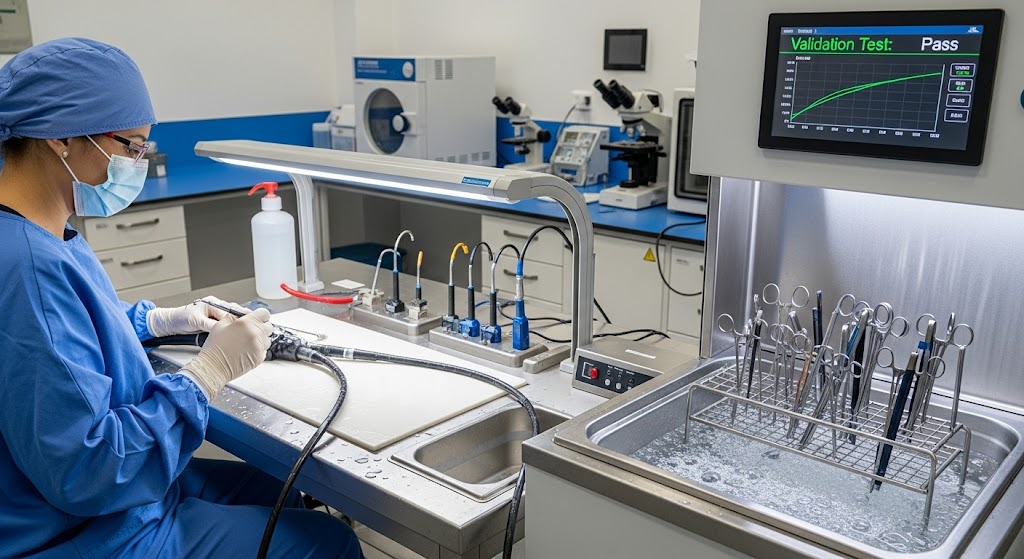In the intricate world of healthcare, the safety of patients is the highest priority. A critical component of this commitment is the proper cleaning, disinfection, and sterilization of reusable medical devices. This process, known as reprocessing medical devices, ensures that tools used on multiple patients are free from contamination and infectious agents. The importance of this practice was brought into sharp focus on March 12, 2015, when the U.S. Food and Drug Administration (FDA) released a final FDA guidance document entitled “Reprocessing Medical Devices in Health Care Settings: Validation Methods and Labeling.” This guidance was a direct response to a series of outbreaks of a drug-resistant “superbug” linked to contaminated duodenoscopes, a type of specialized endoscopy device. This document provides a comprehensive overview for medical device manufacturers, hospital staff, and laboratory professionals on the key requirements of this guidance and best practices for ensuring patient safety.
Understanding the FDA’s Final Guidance on Reprocessing
The FDA’s guidance was a landmark moment for the industry, emphasizing that reprocessing medical devices must be considered an integral part of a device’s design and life cycle, not merely an afterthought. The primary goal of the guidance is to increase the safety of all reusable medical devices by providing clear and effective instructions for use.
- Validation of Reprocessing: The guidance specifies that manufacturers must validate their reprocessing instructions to demonstrate that they are effective and reproducible. This validation process must be performed by a qualified microbiology laboratory to prove that the device can be consistently cleaned, disinfected, and/or sterilized to meet safety standards.
- Labeling and Instructions for Use (IFU): The FDA reviews the IFU for every reusable medical device as part of its regulatory process. The guidance lists specific criteria that must be addressed, including detailed instructions on disassembly, cleaning, disinfection, and sterilization. These instructions must be clear, comprehensive, and able to be correctly followed by end users in a healthcare setting.
Key Elements of an Effective Reprocessing Program
To ensure compliance with the FDA guidance, manufacturers and healthcare professionals must collaborate on a robust reprocessing program that incorporates several key elements.
Reprocessing as a Design Consideration
For a medical device to be effectively reprocessed, its design must facilitate this process. This means avoiding complex geometries, narrow lumens, or intricate joints that are difficult to clean. When a manufacturer designs a new device, they must have a clear plan for how it will be cleaned and sterilized, and this plan must be validated.
The Importance of Microbiology Validation
A crucial part of the guidance is the requirement for microbiology validation. This involves challenging the device with a specific amount of biological soil and microorganisms to confirm that the reprocessing instructions are effective in removing or killing the contaminants.
|
Step in Validation |
Key Objective |
|---|---|
|
Cleaning Validation |
Demonstrating that the cleaning process removes all debris and organic matter from the device. |
|
Disinfection Validation |
Proving that the high-level disinfection process effectively kills microorganisms. |
|
Sterilization Validation |
Confirming that the sterilization process (e.g., steam, ethylene oxide) achieves a sterility assurance level (SAL) of . |
Audits and End-User Training
Even the most robust reprocessing instructions are only effective if they are correctly followed. The FDA emphasizes the need for manufacturers to ensure their instructions are clear and understandable. Hospitals and healthcare settings, in turn, are responsible for providing thorough training to their staff on the correct procedures and for conducting regular audits to ensure compliance.
The Future of Patient Safety and Reprocessing
The FDA’s 2015 guidance has fundamentally changed the landscape of reprocessing medical devices. It places a greater burden of proof on manufacturers to ensure the safety and efficacy of their reprocessing instructions, thereby directly addressing the potential spread of infectious agents. For healthcare professionals, this means having greater confidence in the safety of reusable medical devices, knowing that they have been designed and validated with patient safety as the top priority. This collaborative approach between device manufacturers and end users is essential for maintaining a sterile environment and preventing future outbreaks.
Frequently Asked Questions on Reprocessing Medical Devices
The FDA’s 2015 guidance was a direct response to a serious public health issue involving contaminated duodenoscopes, which were linked to the spread of a drug-resistant “superbug” in several hospitals. The outbreak highlighted the need for more stringent regulations on reusable medical devices.
A manufacturer’s key responsibility is to design reusable medical devices that can be effectively cleaned and sterilized, and to provide clear, validated, and reproducible instructions for reprocessing. The manufacturer must also provide microbiology validation data to the FDA during the regulatory review.
No, reprocessing medical devices is a multi-step process that includes cleaning, disinfection, and potentially medical device sterilization. Sterilization is the final step that kills all microorganisms, including bacterial spores, and is required for devices that enter sterile body tissues or the vascular system.
The effectiveness of a device’s reprocessing instructions is determined through microbiology validation. The manufacturer is required to perform these tests in a qualified laboratory and submit the data to the FDA as part of the device’s regulatory review to demonstrate its safety and efficacy.
This content includes text that has been generated with the assistance of AI. Contract Laboratory encourages the use of new tools and technologies that enhance our editorial process. Our full editorial policy can be found here.

